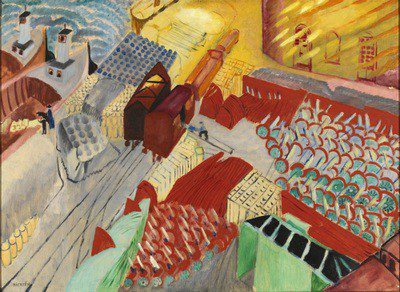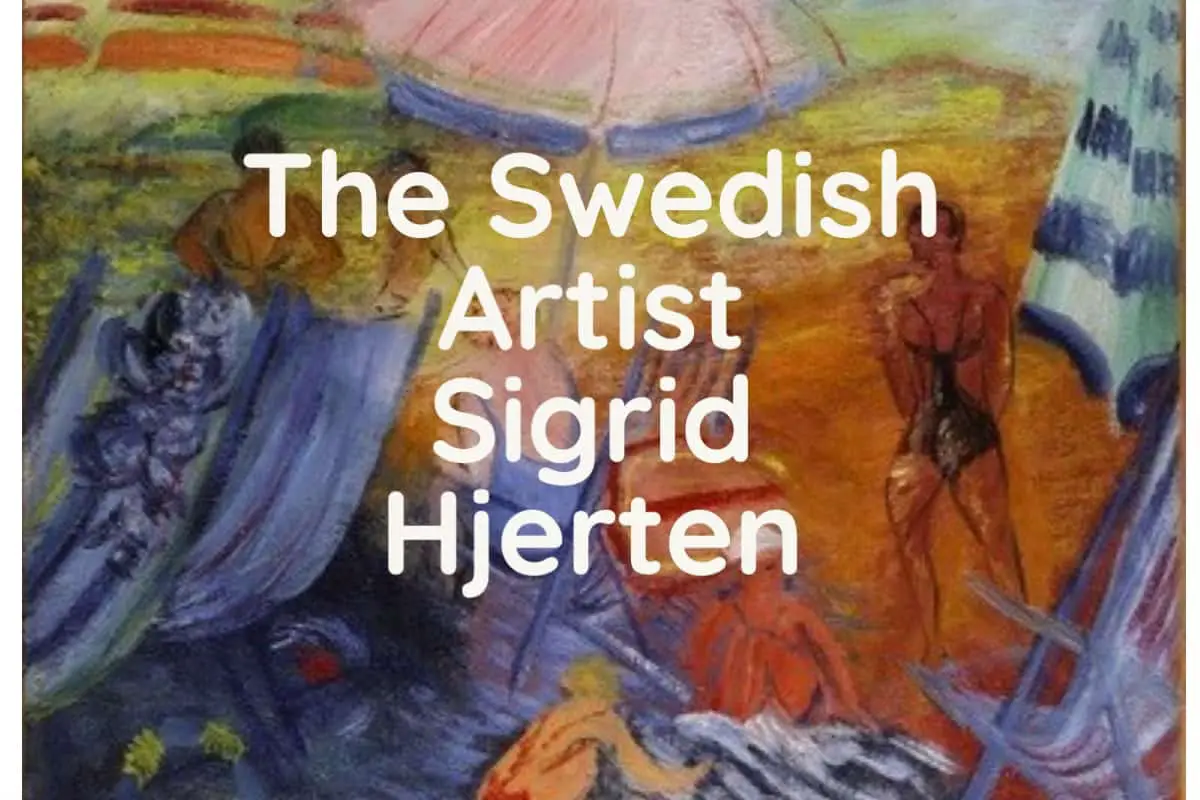I first heard about Sigrid Hjerten when I visited an exhibition of some of her work in 1985 at the Sundsvall Museum in Sundsvall, Sweden. At the time, I loved her work so much I bought a poster that I have had hanging in my house ever since.
Sigrid Hjerten is considered one of Sweden’s most important modern artists. She married the Swedish artist Issac Grunewald, and they both studied together in Paris, France, under Henri Matisse. What made Sigrid stand out is that her artwork was very personal and daring for this time period. She suffered from mental illness and died in Stockholm in 1948.
Table of Contents
- The Early Years – Sigrid Hjerten
- Sigrid Hjerten -Learning from The Master’s in Paris
- The Artist – Sigrid Hjerten
- Later Years Of Sigrid Hjerten
- Frequently Asked Questions
- Related Questions:

The Early Years – Sigrid Hjerten
Sigrid Hjerten was born in 1885 in Sundsvall, Sweden. Sundsvall is a town that is located on the coast in Northern Sweden.
She later attended the University of Arts, Crafts, and Design in Stockholm, Sweden, where she graduated as a drawing teacher. During this time, she was designing textiles. You can see some of the textile design influences in her artwork and paintings.
In 1909 at a Studio Party, she met her future husband, the 21-year-old Swedish- Jewish expressionist painter Issac Grunewald. Issac Grunewald was about four years younger than Sigrid.
Grunewald would go on to become a central figure and name in the first generation of Swedish modernist painters. Throughout his career, he was a well-known artist and was a highly productive painter, writer, and public speaker.
Issac Grunewald was also a professor at the Royal Swedish Academy of Arts and opened his own art school. He did stage designs for the Royal Swedish Opera and other theaters. He also decorated a hall at the Stockholm Concert Hall, where the Nobel Peace Prize ceremony is held each year. This hall has been renamed Grunewald Hall.
The meeting of Isaac Grunewald changed the direction of Sigrid’s life. When they met, Grunewald had already been in Paris one year studying under the direction of the famous French artist Henri Matisse. It was Grunewald who convinced Sigrid that going to Paris to study under Henri Matisse would help her painting.

Sigrid Hjerten -Learning from The Master’s in Paris
In 1910, Sigrid went to Paris to study under Matisse. She was said to be one of Henri Matisse’s favorite students because of Sigrid’s keen sense of color.
Sigrid was said to have been impressed with how both Henri Matisse and Paul Cezanne dealt with color. This clearly shows in her paintings and how she started to deal with color and make color an essential part of her paintings.
Ways Sigrid Hjerten Learned About French Impressionist And Color
Here are some ways that she learned about color from the French Impressionist Artists:
- Contrasting Colors – She learned how to use color as a contrast to achieve the most extraordinary possible expressiveness in her paintings.
- Forms and Colors – She would seek out forms and colors that clearly convey her emotions.
- Patterns and Materials – You can see in her work her textile design background and her attraction to patterns and materials.
During this time, modernism in Swedish art had its breakthrough. This was due to the Swedish artists as Grunewald, Sigrid, and others who were studying under Henri Matisse.
The Swedish modernists used distorted shapes and forms and intensified these forms and color hues. The aim of this artistic choice was to use colors and forms to depict how they saw the modern world.
In 1911, Grunewald and Sigrid’s son Ivan was born. He is frequently used as a subject matter in her paintings.
Sigrid and her family would live between Europe and Sweden for many years. She said she did not do well in the cold Swedish climate, which she called “the bear country.” Because of this, she would spend long periods of time with her family in the more temperate climates of Southern Europe.
The Artist – Sigrid Hjerten
Sigrid Hjerten is a pioneer of Swedish Modernism Art. Today, she is considered to be one of the most important Swedish artists.
We know that Sigrid’s husband, Grunewald was quite a successful artist during his lifetime. There is a myth in the art world that Sigrid herself did not see much success in her lifetime.
The truth is that she participated in over 100 exhibitions both in Sweden and abroad. She also had solo exhibitions at the Royal Academy of Fine Arts in Stockholm and the Goteborg Konsthall.
In fact, her 1936 solo exhibition at the Royal Swedish Academy of Art was so well received that she started to have the national recognition that she deserved. It was said that:
“After viewing the nearly 500 works in her 1936 retrospective, the critics were unanimous; the exhibition was hailed as one of the most remarkable of the season and Sigrid Hjerten was honored as one of Sweden’s greatest and most original modern artists. Thus she gained recognition..”
Ingrid Ingelman
Sigrid was a woman artist in essentially what was a man’s world at the time. She was the only woman member of the artist group De Atta or The Eight. Her husband, Grunewald, was also a member. Some of her views of being a woman in a man’s world are shown in her artwork.

Atelierinteriör (Studio Interior) – 1916
One of her most iconic paintings is the painting of Atelierinteriör or Studio Interior in 1916. This painting really shows how radical Sigrid’s art was for her time.
The painting describes how she saw her life as an artist, woman, and mother. All different identities but a reality to her world.
In the back of this painting, you can see Sigrid sitting in the back on a sofa between two artists – one is her husband, Issac Grunewald, and another is thought to be the Swedish artist and friend, Einar Jolin. But what is interesting is that she is sitting in the middle, being ignored as the two men talk right over her. Her large blue eyes are staring into the distance.
In the foreground is a very sophisticated black woman leaning into a male figure who many think is the Swedish artist Nils Dardel. Many believe this woman to be her alter ego.
In the very right-hand corner is her son Ivan crawling in the background. And on the wall in the center of the painting is a glimpse of one of Sigrid’s paintings called the Gypsy Woman.
This painting was very daring for the time. Many also read it to show a message of how Sigrid felt about her life and her role as a woman artist who was being ignored or talked over in what was then essentially a man’s world.
Later Years Of Sigrid Hjerten
Sigrid Hjerten’s husband, Grunewald, was known to be a womanizer, and eventually, he divorced Sigrid and married Marta Grundell in 1937.
Sigrid suffered from mental illness. In the late 1930s, Sigrid’s mental illness started to escalate. She was diagnosed with schizophrenia and was permanently hospitalized at the Beckomberga Psychiatric Hospital in Stockholm.
It was in this hospital that she would live out the rest of her life. This is also why, from 1938 onward, her artistic output almost stopped.
She died in 1948 at the hospital due to a failed lobotomy.
Sigrid Hjerten is considered to be one of the key Swedish Modernist artists. Her work and subject matter were very daring for her time period and were considered to be very personal in nature.
She left us with over 500 paintings, sketches, watercolors, and drawings. Her artwork is permanently displayed at the Moderna Museet (Modern Art Museum) in Stockholm, Sweden, and Goteborgs Konstmuseum (Gothenburg Museum of Art).
Anita Louise Art is dedicated to art education, great artists, and inspiring others to find and create their art. We love art that uplifts and inspires. #ArtToMakeYouSmile! #ArtToMakeYouHappy!
If you want to see any of my art, you can find out more by clicking here. If you are interested in what inspires me and my paintings, you can discover more by clicking here.
We have a free newsletter and would love you to be part of our community; you can subscribe to the newsletter by clicking here. I would be happy to talk to you if you have any questions. You can reach me, Anita, by clicking here.
Subscribe to our Anita Louise Art YouTube Channel, filled with great videos and information by clicking here.
Join us for our podcast “5 Minutes With Art.” Spend 5 minutes a week with us to discover and learn about great art and artists. You can find out more about our podcast by clicking here.
Frequently Asked Questions
Who was Sigrid Hjerten?
Sigrid Hjerten (1885-1948) was a Swedish modern artist known for her unique and personal artistic style. She is considered one of Sweden’s most important modern artists.
Where was Sigrid Hjerten born?
Sigrid Hjerten was born in Sundsvall, Sweden, in 1885.
What is Sigrid Hjerten known for?
Sigrid Hjerten is known for her daring and personal artwork that pushed the boundaries of the artistic norms of her time. Her paintings often conveyed deep emotions and introspection.
Who did Sigrid Hjerten study under?
Sigrid Hjerten, along with her husband Isaac Grunewald, studied under the renowned French artist Henri Matisse in Paris, France.
What is significant about Sigrid Hjerten’s artwork?
Sigrid Hjerten’s artwork stands out for its personal and emotional content, which was quite daring and unusual for her time. She explored themes of identity, femininity, and mental health in her work.
What is the connection between Sigrid Hjerten and Isaac Grunewald?
Sigrid Hjerten married fellow Swedish artist Isaac Grunewald. They both studied art together under Henri Matisse in Paris and shared artistic influences and experiences.
How did Sigrid Hjerten’s mental illness influence her art?
Sigrid Hjerten’s struggles with mental illness had a profound impact on her art. Her paintings often reflected her inner emotional turmoil and provided a unique perspective into her experiences.
Where can I find Sigrid Hjerten’s work?
Sigrid Hjerten’s artwork can be found in various museums, galleries, and private collections around the world. Some of her notable works are displayed in Swedish museums, such as the Sundsvall Museum.
Related Questions:
Who is the Swedish Artist Hilma af Klint (1862-1944)?
Hilma af Klint is another Swedish woman artist who was painting revolutionary modern artwork for her time. A trailblazing, creative figure she kept her art and paintings secret for many years. Despite her amazing works of art and legacy Hilma left us, it has only been during the last 40 years that she has started to gain international acclaim.
You can find out more about Hilma af Klint by reading our blog Who is the Swedish Artist Hilma af Klint (1862-1944)? by clicking here.
Who Was The Western American Artist Minerva Teichert (1888-1976)?
Minerva Teichert was by all accounts a regular cowgirl from Idaho who loved art. She studied art in both Chicago and New York. Minerva is known for her artwork that depicts daily life in the western United States, historical events, and scenes from the scriptures.
To find out more about Minerva Teichert you can read our blog Who Was The Western American Artist Minerva Teichert (1888-1976)? by clicking here.


